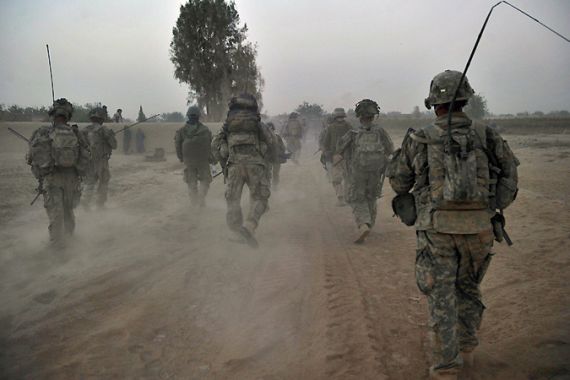Surge in suicides among US soldiers
Figures show suicides among active-duty troops now average almost one a day, outnumbering forces killed in action.

Suicides are surging among US soldiers, averaging nearly one a day this year, according to statistics from the country’s defence department.
The 154 suicides for active-duty troops in the first 155 days of the year outnumber the US forces killed in action in Afghanistan by about 50 per cent, according to statistics obtained by the Associated Press news agency.
Keep reading
list of 4 itemsFirst pig kidney in a human: Is this the future of transplants?
Why are some countries decriminalising drugs?
‘No good evidence’ for gender care for youth over long-term, review finds
The numbers are rising among the 1.4 million active military personnel despite years of effort to encourage troops to seek help with mental health problems.
The reasons for the increase are not fully understood. Among explanations, studies have pointed to combat exposure, post-traumatic stress, misuse of prescription medications and personal financial problems.
Jackie Garrick, head of a newly established Defence Suicide Prevention Office at the Pentagon, said on Thursday that the suicide numbers this year are troubling.
“We are very concerned at this point that we are seeing a high number of suicides at a point in time where we were expecting to see a lower number of suicides,” she said, adding that the weak US economy may be confounding preventive efforts even as the pace of military deployments eases.
Because suicides had levelled off in 2010 and 2011, this year’s upswing has caught some officials by surprise.
Army data suggest soldiers with multiple combat tours are at greater risk of committing suicide, although a substantial proportion of suicides are committed by soldiers who never deployed.
Afghanistan casualties
The unpopular war in Afghanistan is winding down with the last combat troops scheduled to leave at the end of 2014.
|
“He [Major John Roucco] had suffered injury in combat and he had also suffered from depression and let it go untreated for years. And because of that, he’s dead today“ – Kim Ruocco, widow |
But this year has seen record numbers of soldiers being killed by Afghan troops, and there have also been several scandals involving US troop misconduct.
The 2012 active-duty suicide total of 154 through to June 3 compares to 130 in the same period last year, an 18 per cent increase.
This year’s January to May total is 16 per cent ahead of the figures for 2009, which ended with the highest yearly total thus far.
The suicide pattern varies over the course of a year, but in each of the past five years the trend through May was a reliable predictor for the full year, according to a chart based on figures provided by the Armed Forces Medical Examiner.
Sign of weakness
Many in the military believe that seeking health for mental health issues is seen as a sign of weakness and thus a potential threat to advancement.
Kim Ruocco, widow of Marine Major John Ruocco, a helicopter pilot who hanged himself in 2005 between Iraq deployments, said he was unable to bring himself to go for help.
“He was so afraid of how people would view him once he went for help,” she said.
“He thought that people would think he was weak, that people would think he was just trying to get out of redeploying or trying to get out of service, or that he just couldn’t hack it – when, in reality, he was sick.
“He had suffered injury in combat and he had also suffered from depression and let it go untreated for years. And because of that, he’s dead today.”
Ruocco is currently director of suicide prevention programmes for the military support organisation Tragedy Assistance Programs, or TAPS.
The military services have set up confidential telephone hotlines, placed more mental health specialists on the battlefield, added training in stress management, invested more in research on mental health risk and taken other measures.
The suicide numbers began surging in 2006. They soared in 2009 and then levelled off before climbing again this year.
The statistics include only active-duty troops, not veterans who returned to civilian life after fighting in Iraq or Afghanistan.
Nor does the Pentagon’s tally include non-mobilised National Guard or Reserve members – part-time troops who normally divide time between civilian life and military services.